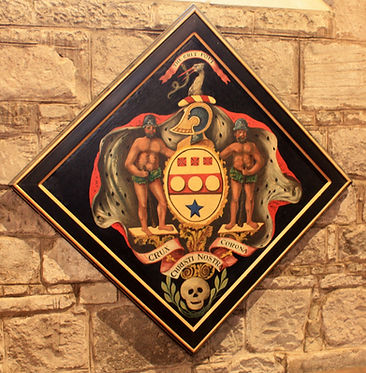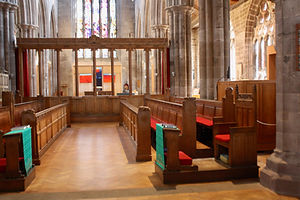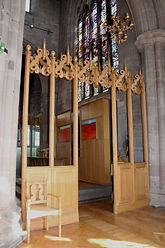
A walk around the Stunning Interior of the Kirk

Enter the Kirk by the West door, descending the steps made necessary by the raised level of the ground around the kirk. Meet one of the Kirk Stewards who will welcome you and give you a copy of an A3 sheet which provides a map and a Guided Tour with numbered stations around the most important features of St. John’s (available in eleven languages).
There is no mediaeval stained glass in St. John’s Kirk. However there are some exceptional windows by acclaimed stained glass artists from the early 20th century, most of them of Scottish origin. The most important were Douglas Strachan, Herbert Hendrie, William Wilson, Meredith Williams and Isobel Goudie, all of whom worked from studios in Edinburgh. An illustrated book, describing the windows, Through a Glass Brightly, by Jeremy Duncan, is available from the Kirk Stewards.

The Blue Window
This window is in the north west corner of the church, behind the church officer’s station. The window features six symbols which are (clockwise from the top left): The Crown, The Gate, The Keys, The River, The Fish, and The Ears of Corn. It was the gift to St. John’s by the Council of the City and Royal Burgh of Perth on the occasion of its dissolution when local government was reorganised in 1975. It is the work of the American stained glass artist Harvey Salvin, who was working in Scotland at the time.

The Halkerston Tower
Walking eastwards in the north aisle, you pass the entrance to the Halkerston tower. This is the door through which a bride enters the Kirk on the occasion of her wedding.


The Black Watch Window
This window is dedicated to the Sixth Battalion of the Black Watch, which served with such distinction in France during the First World War that the French President awarded the Battalion the Croix de Guerre. It is a two-light window, each light featuring a Black Watch soldier. On the left, the soldier is in ceremonial uniform, and is standing in front of the Archangel Michael dressed in armour and slaying the serpent of evil. On the right the soldier is in battle dress, and behind him is St. Andrew, the Patron Saint of Scotland.
The lowest section of the window features the Regimental Badge of the Black Watch on the left, and the Croix de Guerre on the right. Below both is the regimental motto, Nemo me immune lacessit. The window was created by William Wilson.

The Votive Stand
Just beyond the Black Watch window is a Votive Stand - an unusual item for a reformed church. Commissioned by the Friends of St. John’s Kirk, and made by Ratho Byres Forge, it features a single large candle symbolising Christ as the Light of the World which is kept alight whenever the Kirk is open. There are spaces for twelve smaller candles which can be lit from that flame. Visitors and others are invited to light a candle as an act of remembrance, or to give thanks, or as a silent prayer





Niche in the Pillar
Prior to the Reformation there would have been many niches of this type both inside and outside the kirk, each holding a statue of a saint. In St. John’s they were destroyed by John Knox’s ‘rascally mob’ (as described by John Knox himself).
The Shrine and the Statute of John the Baptist
The restoration of St. John’s Kirk was Perth’s tribute to the fallen of the First World War. Within the Kirk, however, the official War Memorial is the Shrine on the west side of the north transept. Designed by Sir Robert Lorimer, it is in the form of an altar within a gothic arch. At the pinnacle of the arch is the Royal Coat of Arms of Scotland, and beneath it two angels hold a crown and saltire above a frame containing the text of the memorial. On the altar are laid the two “Golden Books” which contain the names of those from Perth and Perthshire who perished in each of the World Wars.
Standing guard by the entrance to the shrine is a statue of John the Baptist by the Indian sculptor Fanindra Bose.
The shrine is one of Lorimer’s finest works. On Remembrance Day Sunday, there is a major parade to the kirk, involving members of all the armed services, the Lord Lieutenant of Perth & Kinross, MPs, MSPs, the Provost, councillors and senior officials, all escorted by the Society of High Constables.
Following the two minutes silence wreathes are laid at the memorial.
The Shrine is lit by a three-light window by Morris Meredith Williams. Like the Black Watch window it depicts the Archangel Michael, clad in armour and brandishing a sword. On either side are two bands of warrior angels carrying spears with banners proclaiming Courage, Faith, Fortitude, Hope, Magnanimity and Endurance. With these they are slaying the many headed dragon of Greed, Torment and Cruelty.
There are two other plaques adjacent to the window: a bronze dedicated the men from Perthshire who were killed fighting in the Parachute Regiment and the British Airborne Special forces; and brass plaque celebrating the war effort of the Woman’s Royal Army Corps.
On a nearby pillar hangs a colourful tapestry depicting the many aspects of the life of the 51st Highland Division during the Second World War. In the centre is a map of Scotland showing the recruiting areas of the five regiments (now battalions) of the Division, with their regimental badges. It was unveiled on the occasion of the final reunion of the 51st Highland Division in 2008.

A splendid 15th century brass candelabrum hangs in this transept, close to the Shrine. It was probably made in Holland and features the Madonna at its centre and twelve branches signifying the apostles. It is not electrified.

Tapestry on the wall opposite the Shrine
This remarkable tapestry featuring a representation of the Cross was made by Archie Brennan of Dovecote Studios in Edinburgh

On the north wall of the transept is the funeral hatchment of the Mercers of Aldie , a very important family in mediaeval Perth, several members of whom became Lord Provosts of the city. They had the right to be buried in a vault of the church.

Pews in the North Transept
The pews in the north transept were for members of the Incorporated Guilds of Perth. On the end of these pews are engraved the crests of Perth’s eight ancient guilds
The first pew is decorated with the arms of the Hammermen Incorporation incorporating their motto is: BY HAMMER AND HAND ALL ARTS DO STAND
At the end of this pew is a carved ram . On ceremonial occasions these pews are now used by the members of the Perth Society of High Constables


















The Sanctuary.
The central area of the sanctuary is raised on a low stage to improve the view of the Communion Table and officiating ministers.
Above this area, the square tower is supported by four massive pillars at the corners of the crossing. The ceiling of the crossing is vaulted with a large space in the centre to permit the hoisting of bells into the tower. This is filled by a carved wooden boss depicting Perth’s symbol, Agnus Dei, the Lamb of God with a staff and banner. This derives from the verse in the Bible, (John Chap. 1:v. 29) which records that when John the Baptist saw Jesus approaching he said, “Behold the Lamb of God”. St John’s Kirk is dedicated to John the Baptist, and Perth was, for many years, called St Johnstoun (St John’s town). The Lamb with the staff and banner featured on the ancient crest of the city from mediaeval times up to 1975.
Hanging from two 15th century iron hooks at the entrance to the nave is a large wooden cross
The Communion Table, at the very centre of the crossing is plain but covered with an elaborately embroidered cloth, commemorating the life and work of Alastair Cairncross. On it are two candlesticks which were given by Perth & Kinross District Council in 1993 to mark the 750th anniversary of the Kirk’s consecration.
A modern pulpit now stands in place of the one used by John Knox in his famous sermon on 11th May 1559, which set alight the Scottish Reformation.
Lectern.
The wrought iron and leather lectern features a metal sculpted panel by George Wyllie. Along with the baptismal font, this was installed in the Kirk in 1970.
Great West Window
From the crossing look down the nave to the Great West Window . It is the work of Herbert Hendrie and features a nativity scene (unusual in stained glass windows). There are supporting angels on either side, the crucifixion above, and four scenes from the life of Christ in the lowest section. The background is thick white glass which gives the window an opalescent appearance, and allows light to flood in.
Choir stalls, Ministers’ pews, and screen.
The pre-Reformation choir was divided during the restoration in the 1920s by an open wooden screen, designed by Sir Robert Lorimer. Next to the Sanctuary are the modern choir stalls and the ministers’ pews. Note the carved animals at the ends of the choir stalls.
Mason’s mark.
The south west pillar is much larger than the other three because it incorporates the stairway to the tower. Adjacent to the door into the stairway is an example of a maker’s mark. Each mason had his own mark so that his work could be identified and paid for.
Perth’s Coat of Arms.
On either side of the Sanctuary, the first pews of the transepts are set forward from the rest. The pew in the South Transept is the Provost’s pew, where the provost and distinguished guests sit during official services. On the front of this pew is the coat of arms of the former City and Royal Burgh of Perth, which was abolished in the reorganisation of Local Government in 1975. The double headed eagle is in gold, and on its breast is a red shield, with the Lamb of St. John carrying its staff and banner.
A matching coat of arms is on the front pew of the north transept. This is the coat of arms of the succeeding Perth & Kinross District Council which took over from the City of Perth Council in 1996. The eagle is black with red beaks and claws and a crown around its neck. On its breast is a shield with Loch Leven Castle, superimposed on the lion rampant. The ends of these pews are decorated with carved animals.
The coat of arms of the current Perth & Kinross council differs from its predecessor only in the addition of spikes between the thistles adorning the crown around the neck of the eagle
Both coats of arms were commissioned by the Council and Kirk Session of St John's Kirk in memory of the Late Reverend Allan Young, minister of the Kirk from 1973-1979.
The Organ.
The three manual pneumatic action organ was installed in 1926. It incorporates the 1873 Conacher of Huddersfield instrument, which had served the East Kirk in the building prior to Lorimer’s restoration. It was refurbished in 2003, and the action, now electro-magnetic, is controlled from a detached oak console which can be moved and played in almost any part of the building. The pipes are housed in two splendid oak cases, designed by Sir Robert Lorimer.
Knox Chapel
The east end of the Kirk, the site of the High Altar in the pre-Reformation church, has been converted into the Knox Chapel which is used for small services and meetings. The screen separating it from the choir stalls is part of the Lorimer restoration of 1926, while the screens at the side were designed by Schomberg Scott in 1970.
Painting behind the Communion Table in the Knox Chapel
This work by Hugh Murdoch consists of a group of paintings, and like many modern paintings requires some time and effort to understand.
The blue panels beneath the cross represent the seven days of creation seen through the different aspects of the sea and moon.
The panels on either side represent the outstretched arms of the crucified Christ.
In the centre the two blue panels represent the thieves who were crucified with Christ, while the top painting, seen rising through the darkness into the light, represents the resurrection.
The Great East Window
The Great East Window above the site of the high altar in the mediaeval church was, and is, the most important window in the Kirk. It is a masterpiece by Douglas Strachan, perhaps the foremost stained glass artist in the first half of the 2oth century. Like many windows of this period it is very detailed and binoculars are required to study it properly.
It is a five-light w1ndow, and is divided into three sections. The central part of the upper two thirds of the window dipicts the crucifixion. Both the outer lancets of this upper part of the window feature John the Baptist (to whom St John's Kirk is dedicated), and the lower third of the whole window shows the last supper

Details:
Jesus Crucified.
Christ hangs on his cross in agony beneath Pilate's inscription: I N R I (Jesus of Nazareth, King of the Jews). This illustration captures the detail that is characteristic of the whole window.




The Crucifixion Scene
Jesus hangs on the cross with the city of Jerusalem in the background. Above him are the doves of peace and below the Roman soldiers gamble for robes.
On the left of the scene is hin mother Mary, clothed in a blue robe, being comforted by St. John the Divine. On the right the crowds look on.
Above Mary in the left hand lancet is the figure of the Law wearing a purple robe and holding a scroll in his hand. Above the crowds on the right is the figure of Love holding a chalice.

John the Baptist
The outer lancets of the central section both feature John the Baptist.
On the left he is shown with his staff preaching in the wilderness. The scroll at the foot of the lancet reads, "A voice crying in the wilderness, Prepare ye the way of the Lord".
The lancet on the right shows John the Baptist baptisong Jesus in the River Jordon. There is a dove lookinh down on him, and a scroll at the foot which reads,
"This is my beloved Son in whom I am well pleased"
In the top-most sections of the two outer lancets (above John the Baptist), are two additional illustrations. On the left is a Pelican on its nest, the symbol of self sacrifice, while on the right is the Phoenix, rising from the flames, the symbol of the Resurecction.


The Last Supper
The lowest third of the whole window is taken up with an illustration of the Last Supper showing Jesus with his right hand holding a cup of wine, and his left some bread. There are eleven Disciples illustrated, In this representation, and on the cross, and in the baptismal illustration with John the Baptist, Jesus is featured in plain glass.
Faith Hope and Love
In the stone tracery at the apex of the window are three angelic figures-Faith, Hope and Love







The roof of the choir which was exposed and refurbished by Lorimer. It is one of Scotland’s few surviving mediaeval oak tie beam roofs and is contemporary with the roof of the great hall of Edinburgh Castle
Mediaeval collecting box.
In the south aisle of the choir look beneath one of the windows to see a mediaeval collecting box behind a grille. It belonged at one time to the Hammermen Incorporation.
Adjacent to the South Door is a mediaeval stoup for Holy Water. It was refurbished during the restoration, having been extensively damaged during the Reformation.
South Transept.
On the south wall of the transept is a colourful carved wooden panel dating from the 18th century featuring the insignia of the Wrights Incorporation (53). It was originally in the East Kirk.
The Nave.
The nave was largely reconstructed by Sir Robert Lorimer in the early 1920s. This included a new fumed oak barrel shaped roof, on which are six painted panels depicting the life of Christ. This panel illustrates the text. ‘Suffer the little Children"
On the wall head of the nave are twelve carved wooden shields, each bearing a sacred symbol beneath a crown. Among them is the Lamb with its staff and banner.